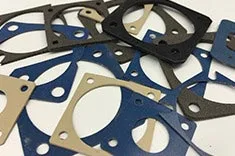EMI Shielding Products
- Custom Gasket Fabrication
- Connector Gaskets
- Bonded O Ring
- Custom Gaskets
- Conduct-O-Knit Knitted Wire Mesh
- Conduct-O-Seal Combo Gasket
- Conduct-O-Elastomer
- Conduct-O-Seal Oriented Wire in Silicone Gasket Material
- Conduct-O-Mesh Tape
- Conduct-O-Foam
- Conduct-O-Bond
- Optical Filters For Electronic Displays
- Shielded Vent Panels
- ESC Board Level Shielding
- 300 Series
EMI Shielding: Meeting the New Wave of Technological Complexity Head-On
 Sudden interference, unexplained equipment lockups, and corrupted data packets can all point to one silent disruptor: electromagnetic interference (EMI). As devices grow more advanced and densely packed, they become increasingly vulnerable to EMI’s intrusive effects. Today’s electronics don’t just coexist with a few simple radio signals—they battle a swarm of noise sources from 5G antennas, electric motors, and countless IoT gadgets jockeying for bandwidth. Without the proper safeguards, a single EMI-related glitch can create a cascade of production setbacks, certification headaches, and user dissatisfaction.
Sudden interference, unexplained equipment lockups, and corrupted data packets can all point to one silent disruptor: electromagnetic interference (EMI). As devices grow more advanced and densely packed, they become increasingly vulnerable to EMI’s intrusive effects. Today’s electronics don’t just coexist with a few simple radio signals—they battle a swarm of noise sources from 5G antennas, electric motors, and countless IoT gadgets jockeying for bandwidth. Without the proper safeguards, a single EMI-related glitch can create a cascade of production setbacks, certification headaches, and user dissatisfaction.
Nothing erodes brand trust quite like persistent, seemingly random device failures. With an ever-increasing number of connected systems—whether in cars, homes, or factories—industry leaders realize the stakes are higher than they’ve ever been. Regulations aimed at forcing higher compliance standards are no longer just formalities; they’re active gatekeepers to a product’s market success. The message is clear: ignoring EMI shielding strategies at the initial design stage invites needless risk, with consequences that can undercut entire business models.
A Rapidly Evolving Industry Landscape
Electronics sectors ranging from consumer products to aerospace now grapple with a surge in performance requirements. Electric vehicles rely on sophisticated powertrain electronics and advanced infotainment systems, all while sharing space with wireless modules tasked with over-the-air updates or real-time diagnostics. Meanwhile, 5G base stations and edge devices operate at cutting-edge frequencies, making conventional shielding methods increasingly inadequate. A single missed interaction—perhaps an overlooked gasket or an inadequate metal enclosure—opens the door to disruptions that ripple through a product’s entire operational life.
Shifting consumer tastes toward ultra-compact, high-power devices compound these challenges further. It’s no longer enough to package a system in a large metal box for isolation; layers of advanced materials or carefully engineered polymer composites often become necessary. In addition to the complexity of multi-layer printed circuit boards and the drive for higher data rates, it’s clear why teams can’t treat EMI management as an afterthought. Instead, a growing number of R&D leaders are examining electromagnetic coupling paths early on—refining ground planes, scrutinizing cable routes, and evaluating each seal or conductive coating with heightened diligence.
Why Proactive Shielding Pays Off
- Fewer Late-Stage Surprises: EMI oversight at the initial concept phase significantly reduces frantic redesigns. The earlier you spot potential interference problems, the simpler they are to correct—boosting your odds of hitting deadlines and budgets.
- Regulatory Advantages: Global authorities are raising the bar on emissions standards, and non-compliance can derail entire product lines. By investing in robust shielding, you align with regulations from the outset, saving time and safeguarding your reputation.
- Customer Confidence: A device that stutters or misbehaves under real-world interference quickly tarnishes brand credibility. On the flip side, well-shielded systems become a selling point. End users may not know the technicalities but appreciate stable, trouble-free performance.
- Long-Term Cost Efficiency: When done post-launch, quick fixes for EMI can become money pits. Contrast that with solutions integrated at the design phase: rework is minimized, field returns drop, and engineering hours remain focused on innovation rather than firefighting EMI crises.
Mastering Today’s EMI Defense Techniques
Leading organizations often adopt a layered approach that combines hardware, materials, and layout optimization. Each choice contributes to an overall noise control strategy, from applying conductive paints on critical surfaces to selecting EMI gaskets that fit precise form-factor demands. In contexts like aerospace or medical devices—where reliability can be life-critical—specialized polymer films, carefully placed ground references, or highly conductive filler materials become indispensable. For industries racing to meet time-to-market pressures, these measures mitigate the risk of setbacks tied to emission issues.
Turning Challenges into Strategic Wins
In a world where electronics shape nearly every facet of innovation, the margin for EMI oversights has narrowed dramatically. Failing to adapt shielding tactics to modern designs exposes firms to compliance hurdles, reputational dents, and a constant cycle of patches that never fully solve the root problem. Conversely, those who see adequate EMI protection as more than a last-minute gate-crasher stand to unlock reliability, market differentiation, and user satisfaction advantages. Ultimately, the technology realm is evolving in leaps, not steps—and those prepared with comprehensive EMI shielding solutions are the ones best positioned to thrive in this dynamic, noise-intensive future.



